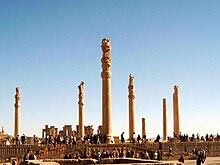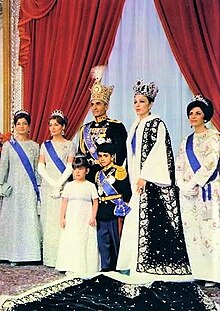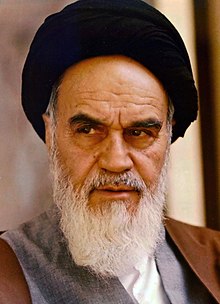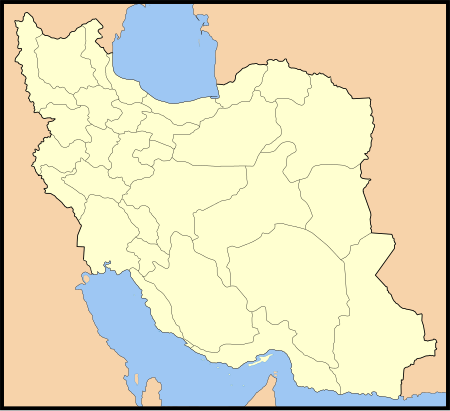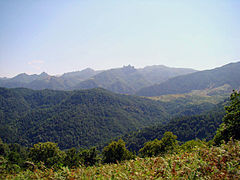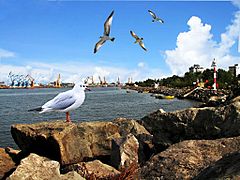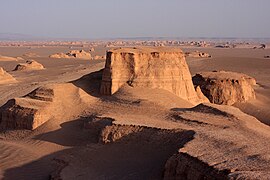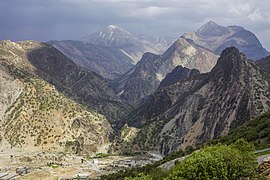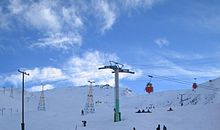Iran
Iran (in Persian, ایران, romanized: Irān), officially Islamic Republic of Iran (in Persian, جمهوری اسلامی ایران, romanized: Jomhuri-ye Eslâmi-ye Iran) is a country in the Middle East and Western Asia. It is a theocratic Islamic republic based on the religious principles of Shia Islam. It is bordered by Iraq and Turkey to the west, Azerbaijan and Armenia to the northwest, the Caspian Sea and Turkmenistan to the north, Afghanistan and Pakistan to the east, and the Gulf of Oman and the Persian Gulf to the south.
Since the 1st millennium B.C. until 1935 it was known in the West as Persia (in Persian, پارس, romanized: Pārs), although today this name is still valid and accepted along with that of Iran.
It is the eighteenth largest country in the world with 1,648,195 km². Iran has a population of almost 100 million people of various ethnic groups. It is a country with a very significant importance in geopolitics as it lies between the Middle East, Central Asia and South Asia. The capital is Tehran, the political, industrial, commercial and cultural center of the country. Iran is a great regional power to which its large hydrocarbon reserves (fourth largest oil reserves and first gas reserves in the world) give it the status of a potential energy superpower and have reported a substantial oil income for decades.
The ethnic diversity of Iranian society, made up of Persians, which is the main ethnic group, Azerbaijanis, Kurds, Luros, Turkmen and Balochis among others, forms an intrinsic part of its culture and has provided a special attraction to this vast territory. Arabs are a small minority in Iran (about 1%).
Iran, along with Iraq, is the cradle of some of the oldest civilizations. The earliest known dynasties in western Iran are those of Elam, from 2800 BCE. C. The Medes formed the first empire to encompass "Greater Iran" in 625 BC. C. These were succeeded by the Achaemenid Empire, Hellenized by the Seleucids after the conquest by Alexander the Great and later refocused on autochthonous references by the successive empires of the Arsacid Parthians and the Sassanids. The Muslims conquer it in 651 AD. C., with the result of the spread of the Persian language throughout the Iranian plateau and of different aspects of Iranian culture throughout the Islamic world.
In 1501, the rise of the Safaví dynasty produced the substitution of Sunni Islam, until then the majority, by Twelver Shi'ism as the official religion of the kingdom, as well as an intense persecution of most of the Sufi brotherhoods developed after the Mongol invasion of the twelfth century. Under the rule of Nader Shah, beginning in 1736, Iran reached its largest land area since Sasanian times. During the 19th century, Iran lost large amounts of territory in the Russo-Persian War (1804-1813) to the Russian Empire in the Caucasus. In the early xx century, the Constitutional Revolution of 1906 established the first legislative assembly of the country (and of the Asian continent), subjecting the monarchical power to a constitution. In 1953, Prime Minister Mosaddeq, who had nationalized oil two years earlier, was overthrown in a coup, orchestrated by the United Kingdom and the United States, allowing Shah Reza Pahlavi to have greater power over the national government. The monarchy came to an end in 1979, through a popular revolution that led to an Islamic revolution, ending up being led by Shiites, led by Khomeini, which led to the establishment of an Islamic republic on April 1, 1979. In 2015 the Joint and Comprehensive Plan of Action was signed with the P5+1 on Iran's nuclear program.
Iran is a founding member of the United Nations, the Non-Aligned Movement, the Organization of Islamic Cooperation and OPEC. The political system of Iran is based on the Constitution of the Islamic Republic of 1979, which regulates the relations between the different government bodies. The highest state authority is the Supreme Leader of Iran, although the day-to-day direction of the administration is the responsibility of the president. The official religion and language of the country are Twelver Shia Islam and Persian, respectively.
Toponymy
The name "Iran" is a cognate of "Aryan", meaning "land of the Aryans". The name appears for the first time in Avestan texts under the form Aryānā vaēža, referring to a region that is usually located in Central Asia. The words Ērānšahr and Ērān have been recorded since Sassanid times, and survived as is until the xxi d. C. in different dialects or oriental languages of Persian and of which the second is already attested in an inscription from the iii century a. C., together with a parallel text in Parthomia in which the ethnonym aryān appears, either with the meaning of "Aryans", "Iranians" or "Iranians".
Until 1935, Iran was known in the West as Persia, a name derived from the Greek Persis, used to refer to the Iranian nation, its people, and its ancient empires. The Iranians identified their country with the name ērān ("of the Iranians") since the Sasanian period. The name Persia comes from the region of southern Iran, called Fars/Pars, derived from Parshua, the place of origin of the Persian Empire.
History
Prehistory
Iran shows traces of human occupation as far back as the Stone Age. During the Neolithic, a process of sedentarization, stable food production and establishment of short-distance exchange routes developed. The Copper Age, characterized by the appearance of copper items and painted pottery in Susiana (southwestern Iran) and in Sialk (central-west), extends in Iran throughout the 4th millennium BC. C. Urban settlements begin to emerge, in a regional process that develops between Anatolia, Mesopotamia, the Bactria-Margiana Archaeological Complex and the Indus Valley Culture.
Antiquity
At the beginning of the 3rd millennium B.C. C. appears in Susa a form of writing, possibly derived from the Sumerian system to represent the Elamite language. The Elamite Empire of southwestern Iran competes with the neighboring empires of Babylonia and Assyria. As of 2000 B.C. C. Medes and Persians, Aryan or Indo-European peoples, began to move from the plains of southern Russia and Central Asia to Europe and Asia. At the end of the VII century B.C. C., groups of Iranian tribes identified as Medes, established to the north and northwest of Iran, get rid of the Assyrian yoke, establishing their power over the region under the leadership of Deyoces, first Sah. Thanks to Ciáxares and Astiages, the Assyrian power ended, taking Nineveh in 612 BC. C. and consolidating the first Iranian empire. From that same period are the sources that mention Cyrus I, King of Anshan.
Median rule, however, was brief, thanks to the work undertaken by a Persian nobleman of the Achaemenid family, Cyrus the Great (555-529 BC), King of Anshan, who unified the Persians, He subdued the Medes and conquered Babylon, Syria, the Mediterranean Levant, and Asia Minor. His work of conquest was continued by his son and successor, Cambyses (530-522), who annexed Egypt and marked the maximum extent of the Achaemenid Empire, configuring the largest known empire in the Near East until then.
The splendor of the Persian Empire is marked by the figure of Darius I (522-486). He was fundamentally dedicated to organizing the extensive empire inherited through satrapies. He elaborated a network of roads with which it was intended to unite the various parts of the empire, the most famous of which is the Royal Road from Susa to Sardis, and also palaces and monuments in the capitals: Susa and Persepolis. He made Mazdaism the official religion. With him also began the decline of the Achaemenid Empire, by undertaking a fight against the Greeks that would be known as the medical wars and that his successors continued: Xerxes I, Artaxerxes I, Darius II, Artaxerxes II and Darius III. Continued defeats by the Persians culminated in the invasion in 334 BC. C. and end of the empire itself by Alexander the Great (336 BC). At his death, his successors divided up his territories, and it passed to Seleucus I Nicator (312 BC).
The Seleucids ruled during a time of great weakness, both external and internal. The decline of the Seleucid Empire was taken advantage of by the Parthian Arsacid dynasty, which ruled ancient Iran from 250 B.C. C. Parthians (Parni) were a people of northern origin, who built an empire from the region on the shores of the Caspian Sea. In the following four centuries, the Parthians defended the territory of ancient Persia against the Romans, while serving as an intermediary between Rome and China. In 224 the Sassanid Empire (224-652) arose, fighting over the centuries against the Romans, the Byzantines and the tribes that harassed it from Central Asia. Only the Arab invasion of the VII century, at the height of the expansion of Islam, could put an end to it with the defeat of the last shah, Yazdgard III.
Middle Ages (652–1501)
In the middle of the VII century, specifically in the year 636 AD. C. (14 of the Hegira), the conquest of Persia by the Arab Muslims took place. The caliphs of Damascus and the first Abbasids were tolerant of the old religions, with Zoroastrian, Monophysite and Nestorian beliefs enduring in Persia. Tendencies contrary to Damascus (Shiism, Khariyism), found their refuge in the Iranian plateau, and ended up intervening in the revolt of 747 against the Umayyads. The new caliphs of Baghdad depended more and more on their military commanders, first Persian and then Turkish. Large areas of Persia escaped their control, becoming independent kingdoms. The revolts against the central power were especially intense in Khorasan, whose first independent kingdom was established by Tahir ibn Husayn, prince of Nishapur, Khorasan and Kerman (822). The first dynasty in Khurasan, after the introduction of Islam, was the Saffarid dynasty (861-1003). The Samanids (875-999), also natives of Khurasan, ruled extensive territories, from the Aral Sea to the Indian Ocean and the Persian Gulf. The Buyites (932-1055) are a dynasty founded by a Persian prince of royal blood close to the Shiites; they reigned in western Persia, then reaching Baghdad, as far as Fars and Kerman. The governor of Khorasan was a Turk who revolted against the caliph in 961 and founded an empire in Ghazna (Afghanistan) that extended to Iranian Khorasan.
The Buyids of Persia found themselves conquered by the Seljuk Turks who, around the year 1000, invaded Khorasan and Iraq. In 1092, on the death of the sultan, Persia became an independent kingdom ruled by one of the sultan's sons. A century later (1190), the Khorezmites founded an Iranian empire over eastern Persia to Afghanistan. The Khorezmites, like the rest of Persia, were conquered by the Mongols under Genghis Khan (1220), founding the Khanate of Persia (or "Iljanato"). Tamerlane's Mongol armies ravaged Persia in 1380-1385. The Timurids ruled from 1370 to 1506.
Modern Age
The 16th century was the century of independence with the Safavid or Sefevid dynasty. It originates from the Sufi religious orders (Shia mystics) from the mountains of Azerbaijan. They organized their state around the sanctuary of Ardabil, near the Caspian Sea. Ismail, its leader, proclaimed himself shah in 1501. The Sefevid kingdom definitively consolidated the difference between the Persians and the rest of the Muslims, by consecrating the pre-eminence of Shiism within Iran. Of this dynasty, it is worth highlighting the reign of Abbas the Great (1587-1629).
Contemporary Age
In 1794 the Zands were removed from power by Agha-Mohamed-Khan, who inaugurated the Kadjar period of Persia. The Kayars ruled Persia from 1786 to 1925. Throughout the 19th century, Persia came under the influence of Russia and the British Empire, which were fighting each other to be the hegemonic power while modernizing the country. In 1907 an Anglo-Russian agreement was reached to differentiate between their areas of influence.
In 1925, Reza Pahlaví, a military chief of nationalist ideology, rose to power. In 1941 Reza Pahlavi abdicated in his son Mohammad Reza Pahlavi's. After World War II the nationalist movement intensified. In 1953, Prime Minister Mohammad Mosaddeq was ousted from power for trying to nationalize oil resources, in a coup d'état orchestrated by the British and Americans through his embassy and called Operation Ajax. The Shah, with the support of the United States and the United Kingdom, began the modernization of the country's industry, and at the same time eliminated all opposition to his regime with the help of the SAVAK Intelligence agency.
Popular discontent erupted in January 1978 with demonstrations against the shah. The shah fled Iran in January 1979, just as Ruhollah Khomeini returned from exile. Iran became an Islamic Republic on April 1 of that same year. Relations with the United States became antagonistic when students from Iran entered and captured the embassy staff of this country and labeled them as spies and linked with the CIA to overthrow the ayatollah as they did with Mosaddeq in 1953. On September 23 In 1980, the war between Iran and Iraq broke out, after the latter country denounced the 1975 border treaty; it ended in 1988. That same year, in 1988, the Islamic regime secretly executed thousands of political prisoners, including members of the PMOI and leftist militants of the Fedaian and the Tudeh (Communist Party); Amnesty International documented the execution of 4,482 prisoners, while the opposition put it at up to 30,000 people. The following year Khomeini died, succeeded by Ali Khamenei as head of state.
In 2002, US President George W. Bush included Iran in the so-called axis of evil, alluding that, according to him, it is a state that supports terrorism. The suspicion that the Iranian nuclear program may have military purposes has led to a confrontation between Iran and Western countries.
The 2009 presidential elections, officially won by outgoing president Mahmoud Ahmadinejad, were contested by the opposition that led to massive demonstrations by supporters of his electoral rival, Mir-Hossein Mousavi, probably the largest since the revolution 1979. Following the conflict, in June 2009 it was reported that German companies in Iran fled following the riots.
Throughout 2011, a series of events took place that further strained relations between Iran and the United States (on the one hand), and Israel and the European Union (on the other). The Islamic Republic has accused Mossad and the US of being behind a series of attacks - some deadly - on physicists working on its nuclear program. For its part, at the beginning of December of the same year, the US accused Iran of having attempted to assassinate the Saudi Arabian ambassador in Washington, something that Iran categorically denied and that some international political analysts described as "crude" #3. 4; American operation. This conflict was followed by the crash of an American unmanned aerial vehicle in Iranian territory, which the US indicated was due to a technical failure, while Iran claimed that it had been shot down by its troops and accused the White House of espionage.. The Iranian refusal to return the remains of it gave another twist to the bad relations between the two countries. From Israel, in addition, Prime Minister Benjamin Netanyahu was exerting pressure on the US, the EU and his own army to attack Iranian nuclear facilities.
On November 12, 2017, a strong earthquake with a magnitude of 7.3 occurred on the border between Iran and Iraq, in the province of Kermanshah, where more than 400 deaths were recorded.
Government and politics
Since the 1979 Islamic Revolution and seven decades of constitutional monarchy, the Iranian state has taken the form of an Islamic republic, in accordance with the 1979 Constitution. The system encompasses several intricately connected governing bodies. The Supreme Leader of Iran is responsible for the delineation and supervision of the general policies of the State. He is, in turn, commander-in-chief of the armed forces and controls the intelligence operations and security of the State. He has the power to declare war, as well as to appoint and dismiss the head of the judiciary, the state radio-television organ, and the top commander of the Islamic Revolutionary Guards Army. He appoints six of the twelve members of the Council of Guardians. The position of leader can be held by an alfaquí -since 1989, Seyyed Ali Khamenei- or by a board of directors, appointed by the Assembly of Leadership Experts, elected by universal suffrage and empowered to remove the leader or leaders.
After the leader, the President of the Republic is the country's highest-ranking official. He is responsible for ensuring that the Constitution is obeyed. He is also the head of the Government of Iran. It should be noted that, unlike what happened in other countries, he is not the head of the Armed Forces.
According to the law, all presidential candidates must be approved by the Guardian Council before they can formalize their candidacy. Once confirmed as candidates, the president is elected by absolute majority under universal suffrage for a four-year term. After his election, the president appoints and oversees the Council of Ministers, coordinates government decisions, and selects government measures that exposed to Parliament. Eight vice presidents serve under the president, as well as a cabinet of 21 ministers, which must be accepted by Parliament.
The Iranian Parliament is unicameral. The Islamic Consultative Assembly is made up of 290 members, elected for a period of four years. They are elected by direct and secret vote, in individual candidacies. Establishes legislation, ratifies international treaties, and approves the country's budget. All legislation in the assembly must be ratified by the Guardian Council, which acts in this sense as an upper house. A constitutional prerogative provides for five seats for representatives elected from among recognized non-Islamic religious minorities: Christians, Jews, and Zoroastrians., which gives them a political representativeness close to the 1.5% they represent. Sunnis vote along with the rest of the population. Candidacies for parliament require the approval of the Guardian Council.
The Assembly of Experts, which meets weekly, is made up of 86 "virtuous and learned" Elected by universal suffrage for a term of eight years. As in presidential and parliamentary elections, eligibility for candidacy is determined by the Guardian Council at this assembly. The members of the Expert Assembly also elect the Supreme Leader from among their own membership and periodically reconfirm him. the assembly challenges a decision of the Leader. Twelve members make up the Guardian Council, six of whom are clerics appointed by the Leader. The head of the judiciary recommends the remaining six, who must be alfaquis—jurists specializing in Islamic law—and are officially appointed by Parliament. The Guardian Council is vested with the power to interpret the constitution and determine whether laws passed by Parliament are in line with the constitution and Sharia (Islamic law). Therefore the Council can exercise a veto over Parliament. If a law passed by Parliament is found to be inconsistent with the Constitution or the Sharia, it is referred back to Parliament for review. The Council also examines presidential, parliamentary and Expert Assembly candidates to confirm their suitability to run for office.
Created by Ayatollah Khomeini in 1988, the State Interest Discernment Council has the authority to mediate conflicts between parliament and the Guardian Council. The Council of Discernment also operates, under basic law, as a consultative body to the supreme leader, making it one of the most far-reaching governing bodies in the country, at least in name.
Iran's political system has features of a presidential, theocratic democracy ruled by a "supreme leader" autocratic. The Iranian regime has been described as authoritarian due to significant lack of freedoms, its theocratic nature, and human rights abuses.
Judicial branch
The head of the judiciary is appointed by the leader, who in turn appoints the chief justice and chief public prosecutor.
Public courts hear civil and criminal cases. There is also a Revolution Court that tries certain categories of crimes, such as crimes against national security, drug smuggling, and acts against the Islamic Republic. The sentences issued in these courts are final and cannot be appealed.
The judgments of the Special Court for the Clergy, which functions independently of the regular judicial framework and answers only to the leader, are also final and cannot be appealed. This Special Administrative Court hears complaints of crimes accused of clergy, although it has also seen cases involving laymen[ citation required].
Armed Forces
The Iranian Armed Forces, consisting of:
- Army of the Islamic Republic of Iran (Artsh), divided into three weapons:
- Army of the Islamic Republic of Iran Land Forces;
- Air Force of the Islamic Republic of Iran;
- Armed Forces of the Islamic Republic of Iran;
- General Military Instruction Centre of the Army of the Islamic Republic of Iran;
- Jatam ol-Anbiá Air Defense System, and:
- Army of Islamic Revolution GuardiansSepah, Pasdarán), current commander Hossein Salami and composed of:
- Earth Forces of the Islamic Revolution Guardian Army;
- Islamic Revolution Guardian Army Air Force;
- Armed Forces of the Army of Islamic Revolution Guardians;
- Qods Force of the Islamic Revolution Guardian Army (Force of Foreign Operations); and
- Organization for the Mobilization of the PoorBasich).
The Iranian army is not in a position to project itself into an external theater of operations and its military apparatus is essentially organized from a defensive perspective. In 2016, the Iranian military budget (including that of the Pasdaran) amounts to 15.9 billion. A number close to that of some of its neighbors, such as Turkey or Pakistan, but far removed from Saudi Arabia (more than 60,000 million), its main regional adversary.
Although Iran is frequently portrayed as a threat by US politicians and diplomats, Barack Obama acknowledged in 2015 that Iran's military budget is only one eighth of that of the US's regional allies and one fortieth of that of the Pentagon.
Human Rights
In terms of human rights, regarding membership of the seven bodies of the International Bill of Human Rights, which include the Human Rights Committee (HRC), Iran has signed or ratified:
Human rights violations in Iran focus on the absence of freedom of expression, freedom of worship, the right to information and the death penalty. Security forces commit human rights abuses and the judiciary does not always prosecute them. Unauthorized street demonstrations or protests are repressed even if they are peaceful. There is the right of assembly but not intellectual freedom. Political opponents, journalists, social activists and human rights defenders, politicians and lawyers are imprisoned. All of them under the specific charge of violation of some law.
Capital punishment is also applied to common criminals such as drug dealers. The government blocks websites and interferes with communications with the outside in the event of a social crisis or social outbreak.
There is a strict dress code, and women and men who break it are jailed. The law provides for stoning for attempting against her in adultery. Sexual minorities are persecuted. In the 2015 Global Gender Gap Index by the World Economic Forum, Iran ranks 137 out of 140 countries.
Territorial organization
Iran is divided into thirty provinces (ostān), each governed by a governor appointed (استاندار, ostāndār) by the Minister of the Interior. Provinces are divided into counties (shahrestān), and further subdivided into districts (bakhsh) and sub-districts (dehestān).
Geography
It is a country dominated by the Iranian plateau, surrounded by various mountain ranges, such as the Zagros mountains (in the southwest) and the Elburz (in the north), the Damavand being in the latter at 5610 m, the highest point country top. The main plains are those along the Caspian Sea coast (aralo-caspian depression) and the Mesopotamian depression in the Persian Gulf near the Iraqi border at Arvandrud (Chat-el-Arab). Iran belongs to the continent of Asia.
It has a continental desert or dry climate. All of Iran is arid or semi-arid, except on the Caspian Sea coast where a temperate climate dominates. The main rivers of Iran are the Sefid-Rud, the Karun and the Hilmand. The main cities are Tehran (the capital), Tabriz, Mashhad, Esfahan, Shiraz, Abadan, Ahwaz and Kermanshah.
Economy
The exploitation of oil in the XX century has caused both the extraction of crude oil, its refining and the production of derived products, is the main source of wealth of modern Iran. Currently Iran has a wide variety of its own technology, with automobile, tractor and machinery factories in general.
Most of the population lives in a self-sufficient primary sector. Sheep farming predominates, in order to obtain wool for the production of Persian rugs. Agricultural land is devoted to cereals (such as wheat), cotton, and tobacco. The service and commercial sector is represented by small private companies.
Because of its well-documented financing and sponsorship of terrorism, the United States has imposed particularly harsh sanctions on Iran since 2018. The American project is to stifle the Iranian economy by halting its trade with the rest of the world. Since then, if a company works with Iran, it is no longer allowed to trade with the United States. Inflation, which had fallen below 10%, has risen to over 40%. The economy is in recession and unemployment is rising again (estimated to be at least 20% in 2019). In September 2019, the US government introduced new sanctions, including 'the last source of revenue for the Central Bank of Iran', which is already on the US blacklist, but also the National Development Fund, "their sovereign wealth fund, which will be cut off" of the US banking system, according to Treasury Secretary Steven Mnuchin. According to Donald Trump, these are "the toughest sanctions ever imposed on a country".
Demographics
The population of Iran in 2017 reached the figure of 82,021,564 inhabitants. Life expectancy is 74 years. 79.4% of the population is literate. The average number of children per woman is 1.71.
Nearly two-thirds of the population speak an Indo-Iranian language, although the only official language is Persian, written in a modified Arabic alphabet. Ethnically 61% are Persian, 9% Kurdish and 2% Baluch. Within the Turkic group, the Azerbaijanis (24%) and Turkmen (2%) stand out, but there are also Arabs (3%), Armenians, Mizrahi Jews, and Assyrians. Arabic is taught in schools, as it is the language in which the Koran is written.
The majority are Muslims: 89% Shiites, the official state religion, and 9% Sunnis. Minority religions include the Bahá'í faith, Zoroastrianism, Judaism and Christianity.
Demographic evolution
- 1857: 4 million.
- 1875: 5 million.
- 1902: 10 million.
- 1929: 12 million.
- 1941: 15 million.
- 1955: 18 million.
- 1965: 25 million.
- 1980: 31 million.
- 1988: 40 million.
- 2000: 65 million.
- 2012: 79 million.
- 2016: 81 million.
Religion
In ancient times there were polytheistic religions in Iran, in the 8th century a. C. Zoroastrianism or Mazdeism begins, which is made an official religion in the vi century. In 636 AD C. the area is conquered by the Arabs and the official religion becomes Islam. The Safaví dynasty, which began in 1501, unifies the country and establishes Twelver Shiite Islam as the country's official religion, which continues to be so in the xxi century.
The Kurdish question
Kurds are subject to certain discrimination: in 2019 they would represent almost half of the prisoners detained for crimes against national security, they are sentenced to disproportionate sentences according to the UN and the Kurdish language is not taught in schools. Above all, provinces with a Kurdish majority are heavily affected by poverty. Although the government refuses to grant them autonomous status, they have relative cultural tolerance: some media outlets are broadcast in Kurdish, and Kurdish clothing and musical traditions are accepted.
For these reasons, the history of the Kurds in Iran has been marked by various uprisings, such as the Republic of Mahabad, when, in 1946, insurgents created an independent Kurdish state before it was destroyed by the Iranian army. There are currently five active Kurdish armed groups: the Kurdistan Democratic Party of Iran (KDPI), the Kurdistan Free Life Party, the Komala, the Kurdistan Freedom Party and the Kurdistan Democratic Party. However, ceasefire agreements of varying duration with the Iranian military have prevented the conflict from escalating.
Starting in 2017, in particular, the PDKI was approached by the United States, which considered using it to deprive Iran of control of its western border. Thus, in June 2018, the party's general secretary went to Washington invited by the US authorities, where he was received by officials from the Department of Defense, including the Department of Iranian Affairs. In 2017, before being appointed National Security Adviser, John Robert Bolton called in an editorial for the US administration to reach out to Iran's ethnic minorities, especially the Kurds, to create a network of regional allies against Iran. That same year, a report by the influential think tank Center for Strategic and International Studies suggested that the United States was supporting the Iranian Kurds to destabilize the Islamic republic from within. However, the PDKI is skeptical, especially since the United States is not loyal to its allies.
Culture
The culture of Iran is a mix between pre-Islamic culture and Islamic culture. Iranian culture probably originated in Central Asia, having its origin in the Andronovo culture 2000 BC. C. Iranian culture has long held a prominent place in Middle Eastern and Central Asian culture, with Persian considered the language of intellectuals for much of the 2nd millennium. During the Sassanid era, Iran influenced Chinese, Indian, and Roman civilization considerably. This influence played a prominent role in shaping the medieval art of Asians and Europeans. This influence spread into the Islamic world. Much of what later came to be called Islamic learning, such as philology, literature, jurisprudence, philosophy, medicine, architecture, and the sciences, is based on some of the practices adopted by the Sasanians and Persians.
Art
The art of the Achaemenid Empire was influenced by Egyptian and Chaldean-Assyrian art. It takes the form of highly monumental constructions, such as the great royal palaces, among which it is worth mentioning that of Cyrus in Susa or those of Darius and Xerxes in Persepolis. It is also worth mentioning the royal tombs, such as the tomb of Ciro or the tombs excavated in the rock. This architecture is ornamented with sculpture, both statues and bas-reliefs. From the Chaldean-Assyrians the Persians took cuneiform writing and representations of mythological animals. They combined Mesopotamian brick with more durable materials like stone; and they also used the architrave system typical of the Egyptians together with the arch and the vault. In these palaces you can see the apadanas or hypostyle ceremonial rooms, with high columns topped with a capital formed by two bull trunks. The polychrome enameled brick or glazed ceramic coverings stand out, among which the best known is the so-called "archers frieze" or "of the immortals" of the Palace of Susa; It is also worth mentioning the "frieze of the bearers of offerings" from the Persepolis palace, and the Davazdah cheshmeh bridge in the historical city of Amol.
In Hellenistic and Roman times (IV century B.C.-III AD) Greek influence was felt. It is later, in the Sassanid period, when Iranian themes were resumed and, in particular, minor arts such as ceramics were promoted. When the Iranian Plateau passed under Arab rule in the 7th century century, the resulting Islamic art retained Iranian features that distinguished it from Islamic art. that was being done in Syria: the architecture continued to be ornamented as in the Sassanid period, materials such as brick or adobe were used and the vault continued to be used. Within the Persian Islamic architecture, the Blue Mosque of Tabriz and the palace of Ispahan stand out.
When Persia fell under Mongol rule, influences from the Far East arrived, and thus the miniature gained popularity, with special Chinese influence; the Persian miniature would reach its maximum splendor in the following century. The fabric also had a great development. Persian art influenced beyond the Iranian plateau, contributing directly to the splendor of Samarkand (in present-day Uzbekistan), where Persian artists worked, this influence can be seen, for example, in the glazed ceramic decoration, in the tall drums that support the domes or muqarnas of the entrance porticoes. As modern architecture, built in the xx century, we can mention the Azadi Monument.
Literature
The Persian language evolved over time. In Old Persian Avestan, an Iranian language related to Sanskrit, Zoroaster's Zend Avesta was written (approximately VII century B.C. C. or century VI BC), which combines poetry with rules of law. Pahlavi Persian develops between the III century and the VII century. The Arab conquest means that this language is used from the vii century onwards. However, the renaissance of a national language occurs from the X century. This is Neo-Persian, in which the great medieval Persian poets such as Rudaki, Firdusi, Hafiz Shirazi, Saadi and Omar Khayyam wrote. In Arabic, the figure of the thinker Algacel stands out.
Current Culture
After the Islamization of Iran, Islamic rituals have penetrated Iranian culture. The most notable of these is the commemoration of Husayn ibn Ali. Every year on the Day of Ashura most Iranians including Armenians and Zoroastrians participate in mourning for the martyrs of the battle of Karbala. Daily life in modern Iran is closely intertwined with Shi'ism, and the country's art, literature, and architecture are an ever-present reminder of its deep national tradition and broader literary culture. Iranian New Year (Nowruz) is an ancient tradition celebrated on March 21 to mark the beginning of spring in Iran. It is also celebrated in Afghanistan, the Republic of Azerbaijan, Uzbekistan, Turkmenistan, Tajikistan, Kazakhstan, and previously also in Georgia and Armenia. It is also celebrated by the Kurds of Iraq and Anatolia. Nowruz was nominated by UNESCO as one of the Masterpieces of the Oral and Intangible Heritage of Humanity in 2004. The Internet is popular among Iranian youth, which has made Iran is the fourth country with the most bloggers in the world.
Cinematography
Iranian cinema has thrived in modern Iran, and several Iranian directors have received worldwide recognition for their work. Iranian films have won more than three hundred awards in the last twenty-five years. One of the best known directors is Abbas Kiarostami. Iran's media is a mix of state-owned and private companies, but books and films must be approved by the Ministry of Culture and Islamic Guidance before being released to the public. In recent years, Iranian cinema has become an expression of freedom and art through which citizens can express their ideas. An example of this is the film This is not a film, directed by Jafar Panahi, which manages to show the conditions that exist in the Persian republic, without losing creativity and humor.
Sports
With two-thirds of the population under the age of twenty-five, Iranians play a wide variety of sports, both traditional and modern. Iran is the birthplace of polo and varzesh-e pahlavani, a traditional fighting sport. Wrestling has traditionally been recognized as the national sport, although the most popular sport is soccer, whose national team has participated in the Soccer World Cup five times and has won the Asian Cup three times. Iran was the first country in the Middle East to host the Asian Games in 1974. It has facilities for skiing, such as the resort located on Tochal Mountain, the fifth largest ski resort in the world (3,730 masl), in the vicinity of Tehran. Due to its orography in Iran, hiking, climbing and mountaineering are practiced. Volleyball is a popular sport due to its participation in the 2013 World League and in the 2015 World Cup.[citation required]
Contenido relacionado
Herod I the Great
Dec. 24
Gules
